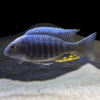-
×

-
×

-
×

-
×

-
×

-
×

-
×

Subtotal: £91.32













Liam Carter (verified owner) –
I recently added the Maylandia Lombardoi, also known as the Kennyi Mbuna Cichlid, to my aquarium, and I couldn’t be happier! After about two months, these little guys have settled in beautifully. Their striking blue and yellow coloration is simply stunning and adds such vibrancy to my tank. I made sure to provide plenty of rock formations and hiding spots, which they absolutely love.
What I appreciate most is their active behavior—they’re constantly swimming around and interacting with each other, which makes for a lively display. I feed them high-quality cichlid food, and they seem to thrive on it. One little tip: make sure your aquarium heater is set to the optimal temperature, as these cichlids prefer warmer waters.
Compared to other cichlids I’ve kept, the Kennyi Mbuna is much more engaging and energetic. They have a personality that’s hard to resist! If you’re a beginner to cichlids or looking to enhance your current setup, I highly recommend these beautiful fish. Just be prepared for some playful territorial behavior—they really do have a character! Overall, I’m thrilled with my purchase and would definitely buy again!